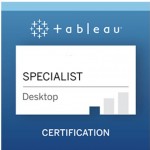Course Duration: 2 Days
 As technology progresses and becomes more interwoven with our businesses and lives, more and more data is collected about business and personal activities. This era of “big data” has exploded due to the rise of cloud computing, which provides an abundance of computational power and storage, allowing organizations of all sorts to capture and store data. Leveraging that data effectively can provide timely insights and competitive advantages.
As technology progresses and becomes more interwoven with our businesses and lives, more and more data is collected about business and personal activities. This era of “big data” has exploded due to the rise of cloud computing, which provides an abundance of computational power and storage, allowing organizations of all sorts to capture and store data. Leveraging that data effectively can provide timely insights and competitive advantages.
The creation of data-backed visualizations is a key way data scientists or any professional can explore, analyze, and report insights and trends from data. Tableau® software is designed for this purpose. Tableau was built to connect to a wide range of data sources and allows users to quickly create visualizations of connected data to gain insights, show trends, and create reports. Tableau’s data connection capabilities and visualization features go far beyond those that can be found in spreadsheets, allowing users to create compelling and interactive worksheets, dashboards, and stories that bring data to life and turn data into thoughtful action.
Course Objectives
In this course, you will visualize data with Tableau. You will:
- Identify and configure basic functions of Tableau.
- Connect to data sources, import data into Tableau, and save Tableau files.
- Create views and customize data in visualizations.
- Manage, sort, and group data.
- Save and share data sources and workbooks.
- Filter data in views.
- Customize visualizations with annotations, highlights, and advanced features.
- Create maps, dashboards, and stories.
Target Student
This course is designed for professionals in a variety of job roles who are currently using a desktop or web-based data-management tools to perform numerical or general data analysis. This includes capturing and reporting on data to peers, executives, and clients. These professionals must also provide data visualizations in reports, or explain data analysis through visualizations.
This course is also designed for students who plan to obtain Tableau® Desktop Qualified Associate certification, which requires candidates to pass the Desktop Qualified Associate exam.
Prerequisites
To ensure your success in this course, you should have experience managing data with Microsoft® Excel® or Google Sheets™. You can obtain this level of skills and knowledge by taking the following Logical Operations courses:
- Microsoft® Office Excel® 2016/2019/Office 365™: Intermediate
Optionally, having experience with other data analytics tools, such as Google Analytics™ or Customer Relationship Management (CRM) tools, as well as an understanding of database design concepts or a background in statistical analysis, will help you get even more out of Tableau. The following courses are helpful but not required:
- Google Analytics™: Foundation
- Database Design: A Modern Approach
- Microsoft® Office Excel® : Dashboards
Course Content
Lesson 1: Tableau Fundamentals
Topic A: Overview of Tableau
Topic B: Navigate the Tableau Interface and Configure Settings
Lesson 2: Connecting to and Preparing Data
Topic A: Connect to Data
Topic B: Prepare Data for Analysis
Topic C: Save Workbook Files
Lesson 3: Exploring Data
Topic A: Create a View
Topic B: Customize Data in Visualizations
Lesson 4: Managing, Sorting, and Grouping Data
Topic A: Adjust Fields
Topic B: Sort Data
Topic C: Group Data
Lesson 5: Saving and Sharing Data
Topic A: Save and Publish Data Sources
Topic B: Share Workbooks for Collaboration
Lesson 6: Filtering Data
Topic A: Configure Worksheet Filters
Topic B: Apply Advanced Filter Options
Topic C: Create Interactive Filters
Lesson 7: Customizing Visualizations
Topic A: Format and Annotate Views
Topic B: Highlight Data
Topic C: Create Advanced Visualizations
Lesson 8: Creating Maps, Dashboards, and Stories
Topic A: Create Maps
Topic B: Create Dashboards
Topic C: Create Stories

